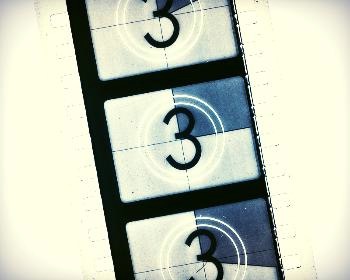
Walla, Ripple, Plop!
I was recently explaining to our intern about how we used to synchronize sound and film together when I realized how many industry terms are borrowed from other tasks or re-hashed from another era. Most make sense, like "copy," "paste," and "edit." But with others you have to make an association. For instance, when you edit film, and I'm talking honest-to-goodness cellulose, you might cut out a bit of a scene to use later. You would hang each piece of film, or "clip," with an actual clip over a rolling cloth bin (like a laundry bin). Many video editing programs use a "bin" to hold all the "clips" of video. Our audio program calls it a "pool," which is similar to a pool of office workers. Though I still think I hear a splash when I open it.
"Spotting" in photography means to retouch the negative. In weight lifting, it's being ready to help someone while they attempt a heavy lift. Both involve using the eyes. In film/video, it's placing sound effects, music or dialog in an exact place that matches the picture.
Here are some of the words we use everyday. If you didn't know these were industry jargon, you might think we were just plain kooky.
You'll see us jog, scrub, nudge, ripple and jam. It's good that we have headroom, bias, and handles. We'll sometimes send a donut, a streamer, and a plop to a bus, and sometimes to a child bus with a daughter card. Would you rather see us heads out, tails out, on-the-fly, or rough cut. You might think we're hard-nosed because we use a guard band, full coat, master, punch-in, or hard-knee. Or maybe we're softies because of soft-knee, pink noise, layback, and flutter. Sometimes we boom with a shotgun, a blimp, a sock, or a dead cat, but never with a figure-of-eight. Sometimes we bounce with pull-up or pull-down, patch a slate, send a stem, loop walla, and solo a mike. Most days, we have to make a choice between a feather, overlap, cross, or a butt. But we rarely encounter wow, combing, crosstalk, or clipping.
Maybe we are kooky after all.
Dynamix Tech Notes
Old fashioned film sound sync is coming back. When I started out in the mid 1980's I worked for a production company that produced most of its content on film. Unlike most video formats, film doesn't have a way to record sound when shooting, so a separate recording is made at the time and synchronized later. This is called "double system" recording. There must be a way to synchronize the sound and picture later in edit, so the most common method is to "slate" each recording. With the popularity of DSLRs to make video now, the old problem is back. DSLRs record sound with the video, but it is poor at best. Low-quality built in microphones and audio inputs make it a choice for amateurs or reference only.
"Roll camera. Roll sound. Slate it. And...action!" That't the most common verbal sequence on the set. The camera starts rolling while zoomed into a handheld slate (or marker). The sound begins rolling. Then a production assistant snaps the top clapper so that the camera sees the exact moment that the hinged top clapper meets the slate board and makes the "crack!" sound. The audio is of course recording this "crack." Each time a take ends and a new recording starts, it must be slated.
Later in the editing room, the editor finds the exact film/video frame that has the clapper meeting the slate board. The audio for that take will have the "crack" sound near the beginning. Visually there's a thin vertical line in the audio waveform (graphical representation of the sound file). That vertical line is lined up with the exact clapper frame. Now the entire take will be in sync.
We used to do all that on film. The good takes and scenes were transferred from reel-to-reel field recordings to sprocketed magnetic film. Because you don't see a waveform with analog recordings, you had to... (drum roll) ...listen. When you heard the clap, you stopped the playback, hit rewind, stopped when you heard the clap (backwards), and then jogged the sound film back and forth until you heard the exact point of the clap. You could then lock the picture and sound together to maintain sync. This entire process of locating, transferring, and locking to picture could take from several hours, to days. That's not counting the time to develop and log the film.
There's now a new and rapid way of synchronizing DSLR footage with separate audio files. During the shoot, audio is recorded separately as in film. The DSLR will also record audio, either from the built in microphone, or a separate feed from the audio mixer. In edit, a software program named PluralEyes will quickly lock up the sound from the audio file with the sound/video from the DSLR file. It looks for matching waveforms of each audio file. This can be done in seconds.
There can be a few problems using this method. If your camera audio has more noise than signal, PluralEyes will have a hard time matching. If your subject is more that 15-20 feet away from the camera and you're using the built in mic, the audio will be off by one frame or more. If this is the case, just drop a split from the audio mixer and feed into the camera.




